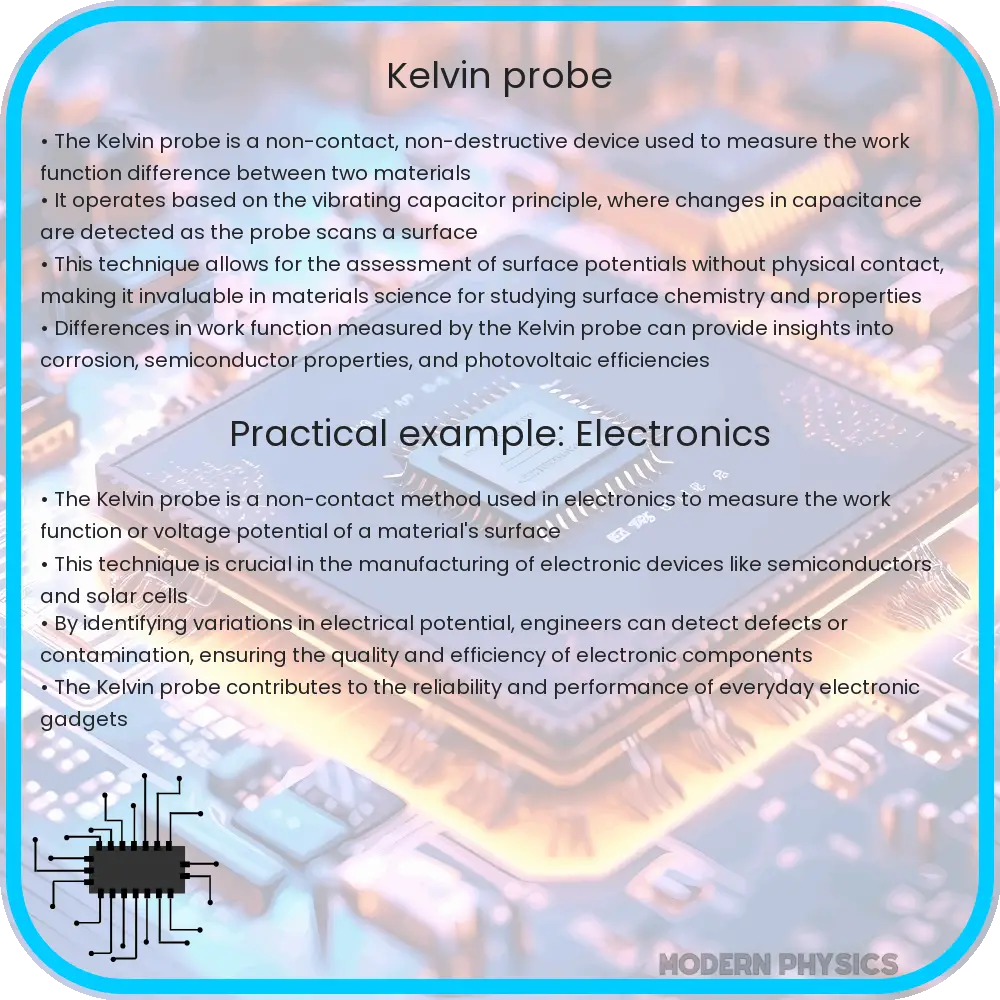Explore the Kelvin Probe technique’s role in surface analysis, charge mapping, and its diverse applications in material and semiconductor research.

Understanding the Kelvin Probe Technique
The Kelvin Probe technique, named after Lord Kelvin, is a non-contact, non-destructive method used for surface analysis and charge mapping. It measures the work function difference between a material under investigation and a reference probe. This technique is pivotal in fields such as material science, corrosion studies, and semiconductor research.
Principles of Kelvin Probe
The fundamental principle of the Kelvin Probe lies in the detection of the contact potential difference (CPD) between a conducting probe and the sample surface. When the probe is brought near the surface, an electrostatic force develops due to the difference in their work functions. The Kelvin Probe system measures this CPD without physical contact, thereby preserving the integrity of the sample.
Applications in Surface Analysis
Kelvin Probe is extensively used in surface analysis to investigate the surface properties of materials. It can provide valuable information about surface heterogeneity, contamination, and oxidation states. By analyzing the work function, scientists can infer about the chemical composition and electronic structure of the surface.
Charge Mapping Precision
The precision of charge mapping with Kelvin Probe is remarkable. It allows for the detailed study of spatial variations in surface potential over large areas. This precision is essential in semiconductor research where even minor variations in charge distribution can significantly impact device performance.
Technical Advancements
Recent advancements in Kelvin Probe technology have enhanced its sensitivity and spatial resolution. The introduction of micro and nano-Kelvin Probes allows for analysis at much finer scales, crucial for nanotechnology and advanced material research.
Conducting Polymers and Corrosion Studies
Kelvin Probe finds significant application in the study of conducting polymers and corrosion. It helps in monitoring the degradation of materials and in the development of corrosion-resistant coatings. By mapping the surface potential, it provides insights into the corrosion process at the micro-level.
This technique, with its non-destructive nature and high precision, opens new avenues in surface science, contributing significantly to the advancement in material research and technology.
Advantages of Kelvin Probe in Semiconductor Industry
In the semiconductor industry, the Kelvin Probe plays a vital role in the characterization of semiconductor devices. It assists in identifying defects and impurities on the wafer surface, which are crucial for the performance of semiconductors. The technique’s ability to measure surface potential variations helps in optimizing semiconductor processing techniques, ensuring higher yields and better device performance.
Environmental and Biological Applications
Beyond material science, the Kelvin Probe has found applications in environmental and biological studies. It aids in the detection of trace gases and pollutants, contributing to environmental monitoring. In biological research, it’s used to study the electrical properties of biological membranes and cells, providing insights into their functioning at the molecular level.
Integrating with Other Techniques
Often, the Kelvin Probe is used in conjunction with other surface analysis techniques like Scanning Electron Microscopy (SEM) and X-ray Photoelectron Spectroscopy (XPS). This combination provides a comprehensive understanding of surface phenomena, correlating electrical properties with structural and chemical characteristics.
Challenges and Future Developments
Despite its advantages, the Kelvin Probe faces challenges like sensitivity to environmental conditions and the need for calibration. Future developments focus on enhancing its accuracy, miniaturization for in-situ measurements, and integration with other analytical techniques for more comprehensive analysis.
Conclusion
The Kelvin Probe technique stands as a cornerstone in surface science and charge mapping, offering unparalleled precision and non-destructive analysis. Its applications span across various domains, from material science to environmental studies, marking its versatility. With ongoing advancements, the Kelvin Probe is set to play an even more significant role in future research and industrial applications. The continuous evolution of this technique will undoubtedly contribute to breakthroughs in various scientific fields, driving innovation and technological progress.
